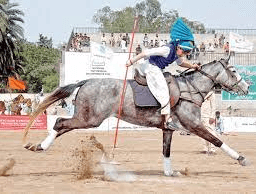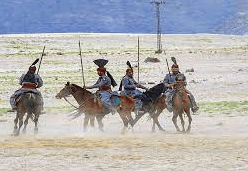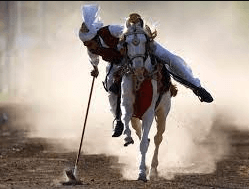Are There Different Styles Or Variations Of Tent Pegging Practiced In Various Countries?

Tent pegging, a sport that originated in ancient times, has gained popularity in various countries throughout the world. This equestrian activity involves riders galloping on horseback and using a sword or spear to pick up small targets on the ground.
While tent pegging is practiced in many different countries, there are indeed variations and styles unique to each region. This article aims to explore the different styles and variations of tent pegging practiced in various countries, shedding light on their origins, techniques, equipment used, and cultural significance.
One of the most renowned styles of tent pegging can be found in India. Here, tent pegging is deeply rooted in history and holds great cultural significance. Riders showcase remarkable skills by picking up wooden blocks placed at varying distances from their horses’ path while maintaining a high speed.
In Oman, another variation called Razfa is popular among equestrian enthusiasts. Razfa involves riders performing intricate maneuvers while holding long spears or lances with flags attached to them.
These examples demonstrate how tent pegging varies not only between regions but also within individual countries, highlighting the diverse nature of this captivating sport.
By studying these different styles and variations of tent pegging across various countries, we gain insight into the evolution and development of this ancient practice over time. Additionally, understanding the techniques employed by riders from different regions allows us to appreciate the level of skill required for this exhilarating sport.
Furthermore, exploring the cultural significance attached to tent pegging provides a deeper understanding of its role as more than just a recreational activity; it becomes an integral part of traditions and heritage for many communities around the world.
As we delve into these fascinating aspects of tent pegging practices worldwide, we embark on an enriching journey that celebrates both freedom and the artistry displayed by these skilled horsemen.
Tent Pegging on Horseback in India
Tent pegging on horseback in India is a traditional equestrian sport that showcases the skilled and precise maneuvers performed by cavalry troops.
This sport is deeply rooted in the cultural traditions of India and has been practiced for centuries.
The training methods for tent pegging involve rigorous exercises to develop balance, coordination, and agility in both the horse and rider.
Riders are trained to gallop at high speeds while accurately spearing targets with their lances.
Additionally, they must demonstrate quick reflexes and excellent horsemanship skills to successfully navigate through obstacles such as hurdles and rings.
The cultural significance of tent pegging in India cannot be understated, as it not only represents a display of military prowess but also serves as a celebration of the country’s rich heritage.
Razfa in Oman
Razfa is a traditional equestrian sport practiced in Oman that showcases the skill and agility of both the rider and the horse.
This style of equestrianism requires precise coordination between the rider and their mount, as they perform various maneuvers with speed and accuracy.
The riders must demonstrate exceptional control over their horses, executing tight turns, quick stops, and intricate patterns to impress spectators.
Showcasing the skill and agility of both the rider and the horse
Demonstrating the finesse and dexterity of both equestrian and equine, tent pegging exhibitions showcase an impressive display of skill and agility.
This ancient equestrian sport requires precise coordination between the rider and the horse as they gallop at high speeds, aiming to strike small targets with a lance or sword.
The historical significance of tent pegging adds to its allure, as it was originally developed as a military training exercise in various countries such as Oman, India, and Egypt.
Today, it has evolved into a popular competitive sport that not only tests the horsemanship skills of riders but also highlights the athleticism and versatility of horses.
The riders must possess exceptional balance and control while maneuvering their horses through intricate patterns and executing complex maneuvers with utmost precision.
Similarly, the horses need to be well-trained, responsive, and agile to swiftly change directions, maintain speed, and carry out the rider’s commands accurately.
Overall, tent pegging showcases a captivating blend of tradition, skillful riding techniques, and remarkable teamwork between horse and rider that truly captivates audiences worldwide.
Precision and coordination required in this style
Precision and coordination are essential elements in the execution of tent pegging, a challenging equestrian discipline that showcases the skill and agility of both the rider and the horse.
This style of riding requires riders to seamlessly synchronize their movements with their horses, ensuring that every action is carried out with utmost precision. The importance of training cannot be overstated in achieving this level of synchronization.
Riders must undergo rigorous practice sessions to develop the necessary muscle memory and timing required for successful performances. They need to master a variety of techniques such as picking up and aiming lances accurately, maintaining proper balance while riding at high speeds, and coordinating their actions with their mount’s movements.
The slightest misjudgment or lack of coordination can result in missed targets or even accidents during the event. Therefore, riders devote countless hours to honing their skills through consistent training, allowing them to achieve an optimal level of precision and coordination when participating in tent pegging competitions.
The Origins of Tent Pegging
The origins of tent pegging can be traced back to ancient warfare practices involving cavalry units. This equestrian sport has a rich historical significance, with roots in the military tactics of various countries. Here are three fascinating aspects of the origins of tent pegging that evoke an emotional response in the audience:
- Ancient Battles: Tent pegging originated as a practical skill used by cavalry soldiers during battles. It was essential for warriors on horseback to have precise control over their weapons and maneuverability. By targeting enemy soldiers with lances or swords while riding at full gallop, tent pegging allowed cavalry units to disrupt enemy formations and create chaos on the battlefield.
- Skill and Training: The art of tent pegging required intensive training and exceptional horsemanship skills. Riders had to develop accuracy, coordination, balance, and timing to successfully strike targets such as wooden or metal pegs driven into the ground. Mastering this demanding sport showcased a warrior’s prowess both on horseback and in combat situations.
- Cultural Significance: Tent pegging not only served as a military tactic but also became an integral part of cultural celebrations in many regions around the world. Over time, it evolved into a popular sport practiced for enjoyment and competition rather than warfare alone. It became a symbol of national pride, showcasing the heritage and traditions associated with horsemanship in different countries.
Understanding the origins of tent pegging provides insight into its historical significance while highlighting its evolution from military strategy to a captivating equestrian sport enjoyed by people worldwide today. With its deep-rooted connections to ancient battles, emphasis on skillful training, and cultural importance across diverse communities, tent pegging represents freedom through mastering control over oneself and one’s trusted steed on an open field of possibility.
European Variations of Tent Pegging
European variations of tent pegging have a long and significant history in the region.
In Europe, tent pegging has evolved into a highly competitive equestrian sport that showcases exceptional horsemanship skills.
European competitions often feature intricate choreographies, precise movements, and astonishing displays of speed and agility.
These events attract participants from various countries who compete against each other to showcase their expertise in this ancient art form.
The historical significance of European variations of tent pegging lies in its roots as a military training exercise.
It was originally practiced by cavalry units to improve their riding skills and prepare for battle.
Over time, it transformed into a popular sport that is now enjoyed by both riders and spectators alike.
The European variations of tent pegging demonstrate the rich cultural heritage and passion for equestrian sports in the region, making them an impressive sight to behold for those with an appreciation for history and athleticism.
Tent Pegging in the Middle East
Tent pegging in the Middle East showcases a centuries-old tradition rooted in military strategy and horsemanship skills.
One notable variation is the razfa practiced in Oman, which is characterized by its emphasis on agility.
The razfa involves riders galloping at high speeds while attempting to pierce targets with their lances.
This demanding and exhilarating sport requires precise timing, coordination, and control over both horse and lance.
It not only showcases the skill of the rider but also highlights the bond between horse and rider as they work together seamlessly to execute intricate maneuvers.
The razfa serves as a testament to the rich equestrian heritage of the Middle East and continues to captivate audiences with its thrilling displays of speed, precision, and agility.
Tent Pegging as a Competitive Sport
Tent pegging has gained popularity as a competitive sport internationally.
Various countries participate in competitions and championships.
These events bring together skilled riders from different nations to showcase their expertise in this unique equestrian discipline.
The sport is governed by specific rules and regulations that ensure fair play, safety, and standardization across all levels of competition.
International competitions and championships
International competitions and championships offer a platform for tent pegging enthusiasts from various countries to showcase their skills and compete against each other.
These international tent pegging competitions not only allow participants to demonstrate their mastery of the sport, but also have a significant impact on local communities.
The global nature of these events brings together people from different cultures and backgrounds, fostering cultural exchange and understanding.
Additionally, the influx of visitors for these competitions can boost tourism in the host country, providing economic benefits for local businesses and communities.
Furthermore, hosting international championships can help promote the sport of tent pegging on a global scale, attracting more participants and spectators in the future.
These events serve as a catalyst for growth and development within the sport, creating opportunities for athletes to push boundaries and achieve new levels of excellence.
Rules and regulations governing the sport
The sport of tent pegging is governed by a set of rules and regulations that ensure fair competition and safety for all participants, contributing to the overall professionalism and credibility of the sport.
These rules vary slightly across different countries, reflecting the cultural traditions and historical significance associated with tent pegging in each region.
For example, in some countries, such as India and Pakistan, where tent pegging has deep roots in their equestrian heritage, there are strict guidelines regarding the size and shape of the pegs used, as well as specific techniques for picking up these pegs while riding at high speeds.
Additionally, international governing bodies like the International Tent Pegging Federation (ITPF) have established standardized rules that apply to competitions worldwide. These rules cover various aspects such as scoring systems, course layouts, horse welfare protocols, and rider attire.
By adhering to these regulations, tent pegging maintains its traditional essence while also ensuring a level playing field for all participants.
Equipment and Techniques in Tent Pegging
One aspect of tent pegging that is worth exploring is the diverse range of equipment and techniques used in this equestrian sport.
Tent pegging has seen numerous innovations in equipment, with advancements made in the design and materials used for lances, swords, and other weapons. These innovations have led to improved accuracy, maneuverability, and safety for both the rider and the horse.
Additionally, training programs have been developed to enhance the skills of both riders and horses in tent pegging. These programs focus on improving balance, coordination, speed, and agility to ensure optimal performance during competitions.
By continually refining equipment and techniques through ongoing research and development, tent pegging continues to evolve as a dynamic sport that captivates its audience’s subconscious desire for freedom.
Cultural Significance of Tent Pegging
The cultural significance of tent pegging can be seen in its role in preserving cultural heritage.
This equestrian sport has deep roots in many countries and is often associated with a country’s history, traditions, and identity.
Additionally, tent pegging also plays a significant role in various festivals and events centered around the sport.
These gatherings provide an opportunity for communities to come together, celebrate their shared heritage, and showcase their skills and horsemanship.
Role in preserving cultural heritage
Playing a vital role in safeguarding cultural heritage, tent pegging serves as a living testament to the ancestral equestrian traditions that have withstood the test of time like an unwavering beacon.
This sport not only preserves cultural practices but also has a significant societal impact by promoting a sense of identity and belonging among communities.
The intricate maneuvers and techniques involved in tent pegging showcase the deep-rooted connection between humans and horses, highlighting their mutual trust and cooperation.
Through this ancient art form, individuals are able to engage with their past, keeping alive the customs and values handed down through generations.
By participating in tent pegging, people can feel connected to their ancestors while also celebrating their own individuality within a collective heritage.
It is this sense of connection and freedom that makes tent pegging so engaging for those who seek a deeper understanding of their cultural identity.
Festivals and events centered around the sport
Festivals and events abound with the vibrant spirit of tent pegging, immersing participants in a world of exhilarating displays, cultural pride, and equestrian prowess.
These gatherings serve as platforms for enthusiasts from various countries to showcase their skills and compete against one another.
The festivals and events centered around tent pegging not only offer a thrilling spectacle for spectators but also hold great cultural significance.
They provide an opportunity for different communities to come together and celebrate their shared heritage, promoting cross-cultural understanding and appreciation.
Moreover, these occasions serve as a means of preserving traditional practices and showcasing the rich history of tent pegging as a sport deeply rooted in the traditions of horse-mounted warfare.
Through these festivals and events, the legacy of tent pegging is kept alive, ensuring that future generations can continue to witness this captivating display of skill and strength while honoring their cultural heritage.
Future of Tent Pegging
In considering the future of tent pegging, it is important to explore how this equestrian sport may evolve and adapt in various cultural contexts around the world.
Future developments in tent pegging could include advancements in equipment and technology, such as more specialized saddles or improved training methods for both horses and riders.
Additionally, there may be a potential for increased global participation in the sport, with countries that have not traditionally practiced tent pegging becoming interested and involved.
This could lead to a greater exchange of techniques and strategies, as well as the development of new variations or styles of tent pegging specific to different regions.
As the sport continues to grow and evolve, it will be interesting to see how different cultures embrace and incorporate tent pegging into their equestrian traditions, ultimately shaping its future direction.
Frequently Asked Questions
What is the historical significance of tent pegging in India?
Tent pegging in India holds immense historical and cultural significance. It represents the valor and equestrian skills of ancient warriors. This thrilling sport showcases the country’s rich heritage and evokes a sense of freedom, captivating its audience with its majestic display.
How is tent pegging different in Oman compared to other countries?
Oman’s unique approach to tent pegging distinguishes it from other countries. This sport promotes horsemanship by emphasizing precision, agility, and control. Its engaging style resonates with an audience’s subconscious desire for freedom and adventure.
What are the different European variations of tent pegging?
One interesting statistic is that there are various European variations of tent pegging, each with its own unique traditional techniques. These variations showcase the diversity and rich history of equestrian sports in Europe, captivating those who yearn for freedom.
Can you provide more information on the equipment and techniques used in tent pegging?
Tent pegging is a traditional equestrian sport that involves riders using lances to pick up and strike targets. This article provides an in-depth look at the equipment and techniques used in tent pegging, as well as its historical significance in India. It explores the various aspects of this engaging sport, catering to an audience with a subconscious desire for freedom.
What is the cultural significance of tent pegging in the Middle East?
Tent pegging, an equestrian sport with Middle East tradition, holds significant cultural value. Its roots lie in ancient cavalry tactics and showcase skills of horsemanship and precision. This captivating sport embodies the spirit of freedom and embodies the region’s rich heritage.
Conclusion
In conclusion, tent pegging is a fascinating equestrian sport that has been practiced in various countries around the world. From its origins in ancient warfare to its modern-day competitive form, tent pegging has evolved and adapted to different cultures and regions.
One can find different styles and variations of tent pegging in countries such as India, Oman, and Europe. Each country brings its own unique techniques and equipment to the sport, adding depth and diversity to the practice. The cultural significance of tent pegging cannot be understated, as it represents not only a display of skill and horsemanship but also a connection to history and tradition.
As we look towards the future of tent pegging, it is clear that this sport will continue to captivate enthusiasts around the world. With advancements in technology and increased global awareness, there are opportunities for further development and expansion of tent pegging as a competitive sport. It is an exciting time for both participants and spectators alike.
In conclusion, tent pegging showcases the beauty of horseback riding combined with precision and skill. Its rich history, diverse variations across different countries, and cultural importance make it a truly remarkable equestrian discipline.
As we move forward, let us appreciate the heritage of tent pegging while embracing new possibilities for its growth on an international scale.



